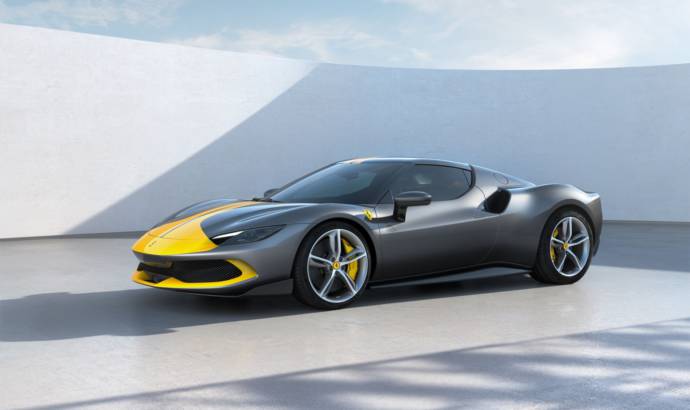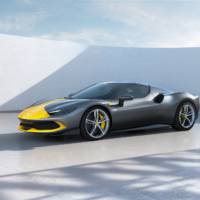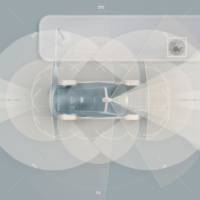Ferrari revealed a new model that continues the road to electrification for the Maranello-based brand. The Italians wowed everyone with the 296 GTB, the latest evolution of Maranello’s mid-rear-engined two-seater berlinetta.
The 296 GTB redefines the whole concept of fun behind the wheel, guaranteeing pure emotions not just when pushing the car to its limits, but also in day-to-day driving situations.
The 296 GTB ushers in an authentic revolution for Ferrari as it introduces a new engine type to flank the marque’s 8- and 12-cylinder power units: a new 663 cv 120° V6 coupled with an electric motor capable of delivering a further 122 kW (167 cv). This is the first 6-cylinder engine installed on a road car sporting the Prancing Horse badge; it unleashes its 830 cv total power output to deliver previously unthinkable performance levels and an innovative, exhilarating and unique soundtrack.
The car’s name, which combines its total displacement (2992 l) and number of cylinders was chosen, with the addition of the GTB (Gran Turismo Berlinetta) acronym in finest Ferrari tradition, to underscore this new engine’s epoch-changing importance to Maranello. It is not simply the living, beating heart of the 296 GTB, but it also ushers in a new V6 era that has its roots deep in Ferrari’s unparalleled 70-year-plus experience in motor sports.
The 296 GTB’s plug-in hybrid (PHEV) system guarantees it is an incredibly usable car as well as cutting pedal response times to zero and delivering a 25km range in all-electric eDrive mode. The car’s compact dimensions and the introduction of innovative dynamic control systems as well as meticulously honed aero ensure that the driver will instantly experience its astonishing agility and responsiveness to commands. Its sporty, sinuous design and extremely compact dimensions also visually underscore its exceptional modernity, brilliantly referencing the likes of the 1963 250 LM, the perfect marriage of simplicity and functionality.
As was the case with the SF90 Stradale, for clients who want to exploit the car’s extreme power and performance to the utmost, particularly on the track, the 296 GTB is also available with the Assetto Fiorano package, which includes lightweight features and aero modifications.
The 296 GTB is the first Ferrari road car to sport a V6 turbo with a vee with an angle of 120° between the cylinder banks, coupled with a plug-in electric motor. This new V6 has been designed and engineered from a clean sheet by Ferrari’s engineers specifically for this installation and is the first Ferrari to feature the turbos installed inside the vee. Aside from bringing significant advantages in terms of packaging, lowering the centre of gravity and reducing engine mass, this particular architecture helps deliver extremely high levels of power. The result is that the new Ferrari V6 has set a new specific power output record for a production car of 221 cv/l.
As the V6 turbo is integrated with an electric motor at the rear, the 296 GTB’s combined maximum power output is 830 cv, putting it at the top of the rear-wheel-drive sports car segment as well as making it extremely flexible. This is true both in terms of day-to-day contexts (the 296 GTB has a full-electric mode range of 25 km), and in driving enjoyment (accelerator pedal response is instant and smooth at all engine speeds).
The powertrain assembly comprises a V6 turbo ICE, with the 8-speed DCT and E-Diff, and the MGU-K located between the engine and the gearbox. A clutch is set between the ICE and the electric motor to decouple them in electric-only eDrive mode. Lastly there is a high-voltage battery and the inverter which controls the electric motors.
Thanks to its 663 cv and 221 cv/l, the 296 GTB’s ICE sets the new specific power output record for a production road car. Central to achieving this result was the introduction of the 120° vee configuration with equally-spaced firings as well as the positioning of the turbos inside the vee which produces a much more compact engine and optimally distributed masses.
The architecture is also ideal in terms of combustion sequence and the integration of the intake plenums and the engine supports on the intake sides of the cylinder heads. The engine is thus lighter and more compact because of the elimination of the plenums and exterior supports, while the fluid-dynamics benefit from the reduction in volumes, boosting intake efficiency. The 120° vee architecture, which offers more space between the cylinder banks than a 90° vee, meant the turbos could be installed centrally, thus significantly reducing the unit’s overall size and the distance the air has to cover to arrive in the combustion chamber, maximising the fluid dynamics and efficiency of the intake and exhaust line ducts.
This is the first ever Ferrari with a rear-wheel drive-only PHEV (Plug-in Hybrid Electric Vehicle) architecture in which the ICE is integrated with a rear-mounted electric motor producing up to 122 kW (167 cv) derived from the Formula 1 application from which it also inherits the MGU-K (Motor Generator Unit, Kinetic) moniker. The electric motor and ICE communicate via the Transition Manager Actuator (TMA) which allows them to be used both together to produce a combined power output of 830 cv or decouples them to allow the electric motor to run solo.
Aside from the V6 turbo and the 8-speed DCT already adopted on the SF90 Stradale, Ferrari Roma, Portofino M and the SF90 Spider, the powertrain architecture also includes the MGU-K electric motor positioned between the engine and gearbox, the TMA to decouple the electric motor from the ICE, the 7.45 Kwh high voltage battery, and the inverter which controls the electric motors.






